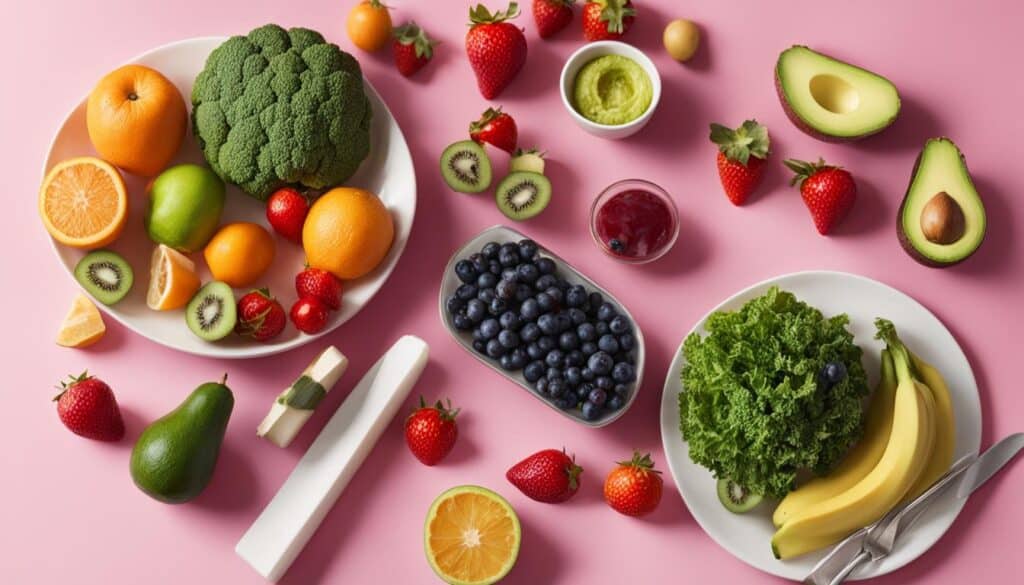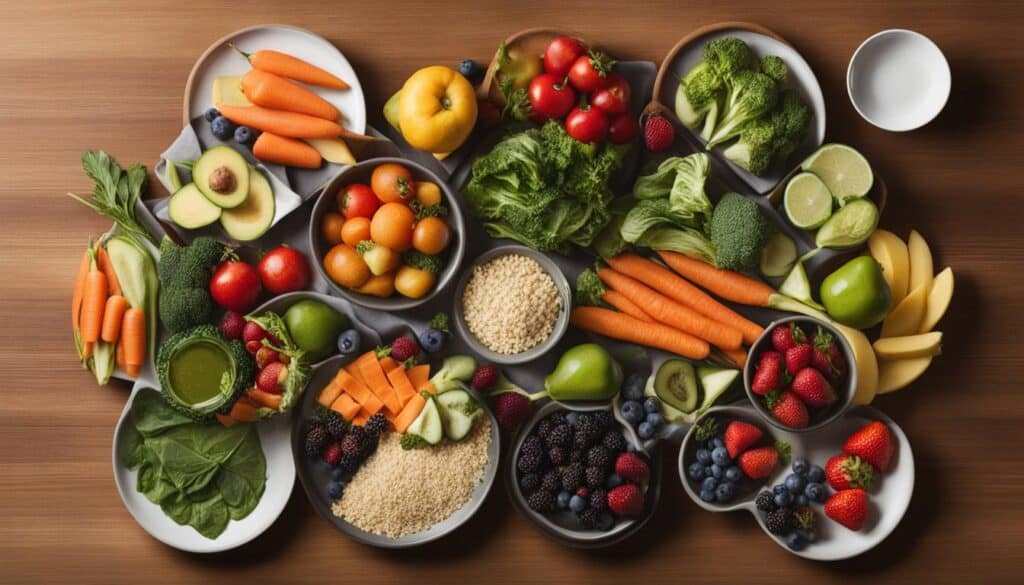Welcome to my guide on high calorie fruits, where I’ll explore the world of calorie-rich fruits and their nutritional benefits. Fruits are not only delicious but also pack a powerful punch when it comes to energy content. Whether you’re looking to fuel your workouts or simply enjoy a nutritious snack, high calorie fruits have got you covered.
When we talk about high calorie fruits, we’re referring to energy-dense fruits that provide a substantial amount of calories. These fruits are a great source of natural sugars, essential nutrients, and fiber. By incorporating them into your diet, you can boost your calorie intake while also reaping the many health benefits they offer.
Throughout this guide, we’ll delve into the recommended amount of fruit consumption, equivalent measurements for a cup of fruit, the benefits of eating fruits, and specific high-calorie fruits that can support weight gain or muscle-building efforts. We’ll also explore different ways to incorporate these fruits into your diet and emphasize the importance of a well-rounded and balanced approach to eating.
Key Takeaways:
- High calorie fruits are energy-dense fruits that provide a substantial amount of calories.
- Incorporating high calorie fruits into your diet can help boost your calorie intake and provide essential nutrients.
- Fruits should be consumed in recommended amounts based on age, gender, and physical activity level.
- There are various equivalent measurements for a cup of fruit, allowing for accurate serving sizes.
- Eating fruits has numerous health benefits, including reducing the risk of chronic diseases.
How Much Fruit Should You Eat?
The recommended amount of fruit consumption varies based on factors such as age, gender, and physical activity level. It’s important to understand the guidelines for fruit intake to ensure a well-rounded and nutritious diet.
For toddlers aged 12 to 23 months, half to one cup of fruit is recommended. Children aged 2-3 years should consume 1 to 1½ cups of fruit, while children aged 4-8 years should consume 1 to 2 cups. Girls aged 9-18 years and boys aged 9-13 years should consume 1½ to 2 cups of fruit, while girls aged 14-18 years and boys aged 14-18 years should consume 1½ to 2½ cups. Women aged 19-30 years and 31-59 years should consume 1½ to 2 cups of fruit, while women aged 60+ years should consume 1½ to 2 cups. Men aged 19-30 years and 31-59 years should consume 2 to 2½ cups of fruit, while men aged 60+ years should consume 2 cups of fruit. These guidelines help ensure individuals meet their nutrient needs and maintain optimal health.
| Age Group | Recommended Fruit Intake |
|---|---|
| Toddlers (12-23 months) | ½ to 1 cup |
| Children (2-3 years) | 1 to 1½ cups |
| Children (4-8 years) | 1 to 2 cups |
| Girls (9-18 years) | 1½ to 2 cups |
| Boys (9-13 years) | 1½ to 2 cups |
| Girls (14-18 years) | 1½ to 2½ cups |
| Boys (14-18 years) | 1½ to 2½ cups |
| Women (19-30 years) | 1½ to 2 cups |
| Women (31-59 years) | 1½ to 2 cups |
| Women (60+ years) | 1½ to 2 cups |
| Men (19-30 years) | 2 to 2½ cups |
| Men (31-59 years) | 2 to 2½ cups |
| Men (60+ years) | 2 cups |
It’s important to note that these are general guidelines, and individual needs may vary. Factors such as physical activity, health conditions, and personal preferences should also be taken into consideration. Consulting with a healthcare professional or registered dietitian can provide personalized recommendations for fruit consumption.
Why is Fruit Intake Important?
Fruits are packed with essential vitamins, minerals, fiber, and antioxidants that support overall health and well-being. They provide a wide range of nutrients that help maintain a healthy immune system, promote proper digestion, and reduce the risk of chronic diseases such as heart disease, stroke, and certain types of cancers. Regular fruit consumption is also associated with weight management and can help individuals meet their daily nutritional requirements.
The guidelines for fruit intake serve as a helpful tool to ensure individuals consume an adequate amount of fruits to reap their numerous health benefits. By incorporating a variety of fruits into the daily diet, individuals can enjoy their natural sweetness while nourishing their bodies with essential nutrients.
What Counts as a Cup of Fruit?
When it comes to measuring fruit servings, it’s important to know what counts as a cup of fruit. Different fruits have varying serving sizes that are equivalent to one cup. Let’s take a look at some examples:
| Fruit | Equivalent Measurement |
|---|---|
| Apple | One small or half a large apple |
| Banana | One large banana or one cup of sliced bananas |
| Blueberries | One cup of fresh or frozen blueberries |
| Cantaloupe | One cup of diced or melon balls of cantaloupe |
| Casaba Melon | One cup of diced or melon balls of casaba melon |
These are just a few examples of the wide variety of fruits and their equivalent measurements for one cup. Knowing these measurements can help you accurately measure your fruit servings and ensure you’re meeting the recommended amount for your daily intake.
By incorporating a variety of fruits into your diet and understanding what counts as a cup, you can enjoy the nutritional benefits and delicious flavors that high-calorie fruits have to offer.
Benefits of Eating Fruits

Eating fruits offers a wide range of health benefits that contribute to overall well-being. Fruits are known to be low in calories, high in fiber, and packed with essential nutrients such as vitamins, minerals, and antioxidants. Incorporating fruits into your diet can help maintain a healthy weight and reduce the risk of chronic diseases, including heart disease, stroke, and certain types of cancers. The natural sugars in fruits provide a delicious and satisfying alternative to processed sweets, making them an excellent choice for those looking to improve their diet and overall health.
Fruits are also rich in fiber, which aids in digestion and promotes a feeling of fullness, helping to prevent overeating. The fiber content in fruits can also support healthy blood sugar levels and reduce the risk of developing type 2 diabetes. Additionally, consuming a variety of fruits can contribute to a balanced diet by providing a wide range of essential nutrients that are necessary for optimal health.
Research has shown that the antioxidants found in fruits play a crucial role in protecting the body against oxidative stress and inflammation. These antioxidants help neutralize harmful free radicals in the body, which can damage cells and lead to various diseases. By including a variety of fruits in your diet, you can benefit from their antioxidant properties and support a healthy immune system.
The Role of Fruits in Disease Prevention
Fruits have a significant impact on disease prevention and overall health. Their high nutrient content and antioxidant properties contribute to a lower risk of chronic diseases.
| Health Benefit | Role of Fruits |
|---|---|
| Heart Health | Fruits like berries, oranges, and grapes are rich in antioxidants and phytochemicals that can reduce the risk of heart disease by lowering blood pressure, improving cholesterol levels, and reducing inflammation. |
| Cancer Prevention | The antioxidants and fiber in fruits help protect against certain types of cancers, such as lung, mouth, and stomach cancers. Fruits like berries, citrus fruits, and tomatoes are particularly beneficial. |
| Weight Management | Fruits are low in calories and high in fiber, which can promote satiety and help control appetite. Including fruits in your diet can support weight loss or weight maintenance goals. |
| Diabetes Prevention | Fruits with a low glycemic index, such as berries and cherries, can help regulate blood sugar levels and reduce the risk of developing type 2 diabetes. |
| Digestive Health | The fiber content in fruits promotes regular bowel movements and prevents constipation. Fruits like bananas and apples are particularly beneficial for digestive health. |
Incorporating a variety of fruits into your diet is an essential part of promoting good health and preventing chronic diseases. Enjoy fruits as a refreshing snack, add them to your breakfast or salads, or use them in smoothies and desserts. With their natural sweetness, abundant nutrients, and numerous health benefits, fruits are a delicious and nutritious addition to any diet.
High-Calorie Fruits for Weight Gain
When it comes to weight gain or muscle-building goals, incorporating calorie-dense fruits into the diet can be beneficial. These fruits are packed with natural sugars and have a higher calorie content, making them excellent options for individuals looking to increase their calorie intake. Some of the top high-calorie fruits for weight gain include bananas, avocados, mangoes, dates, and figs.
Bananas are not only a convenient and portable snack, but they are also rich in carbohydrates and provide a good source of energy. Avocados, known for their creamy texture, are high in healthy monounsaturated fats, which can contribute to weight gain in a balanced manner. Mangoes are not only delicious but are also high in calories and provide a good source of fiber and vitamins. Dates and figs are dense in calories and contain natural sugars, making them ideal for increasing calorie intake.
It’s important to remember that weight gain or muscle-building should be approached in a healthy and balanced way. Consultation with a healthcare professional or a registered dietitian can provide personalized guidance and ensure that dietary changes are appropriate for individual needs. Incorporating high-calorie fruits into the diet is just one component of a well-rounded approach to achieving weight gain goals.
| Fruit | Calories per 100g |
|---|---|
| Bananas | 96 |
| Avocados | 160 |
| Mangoes | 60 |
| Dates | 282 |
| Figs | 107 |
Table: High-Calorie Fruits for Weight Gain
Incorporating High-Calorie Fruits into the Diet
When it comes to incorporating high-calorie fruits into your diet, there are plenty of delicious and nutritious options to choose from. These fruits not only provide a natural source of energy but also offer a wide range of essential nutrients. Here are some creative and tasty ways to enjoy these calorie-rich fruits:
1. Smoothies
Smoothies are a great way to incorporate high-calorie fruits into your diet. Blend fruits like bananas, avocados, or mangoes with milk or yogurt for a creamy and satisfying drink. You can also add protein powder or nut butter for an extra boost of nutrition. Experiment with different flavor combinations and create your own signature smoothie recipe.
2. Salads
High-calorie fruits like avocados and mangoes can add a burst of flavor and richness to your salads. Slice them and toss them with leafy greens, nuts, and a light dressing for a refreshing and filling meal. You can also try adding diced apples or raisins to give your salad a touch of sweetness.
3. Desserts
Who says desserts can’t be healthy? Incorporate high-calorie fruits into your sweet treats for a guilt-free indulgence. Top your yogurt or oatmeal with sliced bananas or berries, or make a fruit crumble using apples or peaches. These fruity desserts are not only delicious but also packed with vitamins and antioxidants.
By incorporating high-calorie fruits into your diet in creative ways, you can enjoy their nutritional benefits while satisfying your taste buds. Remember to consume them in moderation as part of a balanced diet.
| Fruit | Suggested Recipe |
|---|---|
| Bananas | Chocolate Banana Nut Shake (banana, chocolate whey protein, peanut butter) |
| Avocados | Avocado Toast (toasted bread, mashed avocado, optional toppings) |
| Mangoes | Mango Salsa (diced mangoes, red onion, jalapeno, lime juice) |
Other Factors to Consider for Weight Gain

When it comes to achieving balanced weight gain, incorporating high-calorie fruits is just one piece of the puzzle. There are other factors to consider that can help support your goals. Two important factors to focus on are protein and healthy fats.
Protein: Protein is essential for muscle growth and repair. Including adequate amounts of protein in your diet is crucial for gaining lean muscle mass. Good sources of protein include dairy products, lean meats, fish, eggs, and legumes. These foods provide the necessary amino acids that your body needs to build and repair muscle tissue.
Healthy Fats: Healthy fats are another important component of weight gain. They are calorie-dense and can help increase your overall calorie intake. Incorporating sources of healthy fats, such as nuts, seeds, avocados, and olive oil, into your diet can provide additional energy and support your weight gain goals. Additionally, healthy fats are important for overall health and can contribute to a well-rounded diet.
Sample Table: Protein and Healthy Fat Content in Common Foods
| Food | Protein Content (g) | Healthy Fat Content (g) |
|---|---|---|
| Chicken Breast (3 oz) | 26 | 2.8 |
| Greek Yogurt (1 cup) | 23 | 6 |
| Salmon (3 oz) | 22 | 13.5 |
| Almonds (1 oz) | 6 | 14 |
| Avocado (1/2 medium) | 2 | 15 |
By including protein-rich foods and healthy fats in your diet along with high-calorie fruits, you can create a well-rounded approach to weight gain. It is important to remember that weight gain should be approached in a healthy and balanced manner. Consulting a healthcare professional or a registered dietitian is recommended to tailor a plan that suits your individual needs and goals.
The Importance of Diet Quality

When it comes to healthy eating, focusing on diet quality is key. It’s not just about the quantity of food we consume, but also the types of foods we choose. By prioritizing nutrient-dense foods, we can ensure that we are getting the essential vitamins, minerals, and other beneficial compounds our bodies need.
What exactly does diet quality mean? It means selecting foods that are rich in nutrients and provide a wide range of health benefits. These include fruits, vegetables, whole grains, healthy fats, and lean proteins. These foods are packed with essential nutrients and can help maintain a healthy weight, reduce the risk of chronic diseases, and support overall well-being.
One way to determine the quality of your diet is by looking at the types of carbohydrates you consume. Instead of focusing solely on the amount of carbs, it’s important to choose complex carbs from whole grains, fruits, and vegetables over refined carbohydrates like white bread and sugary snacks. These complex carbs provide more fiber, vitamins, and minerals, and have a positive impact on our health.
By following a diet that emphasizes nutrient-dense foods, we can nourish our bodies and promote overall wellness. It’s not about strict restrictions or counting calories, but about making informed choices and enjoying a variety of wholesome foods. By doing so, we can create a healthy eating pattern that supports our long-term health goals.
Table: Nutrient-Dense Foods for a Healthy Diet
| Food Group | Examples |
|---|---|
| Fruits and Vegetables | Apples, oranges, broccoli, spinach |
| Whole Grains | Brown rice, quinoa, whole wheat bread |
| Healthy Fats | Avocado, nuts, olive oil |
| Lean Proteins | Chicken breast, tofu, salmon |
Table: Nutrient-Dense Foods for a Healthy Diet
- Choose a variety of colorful fruits and vegetables to get a range of vitamins and minerals.
- Opt for whole grains like brown rice and whole wheat bread for added fiber and nutrients.
- Incorporate healthy fats from sources like avocados, nuts, and olive oil for heart-healthy benefits.
- Include lean proteins like chicken breast, tofu, and salmon for essential amino acids.
By incorporating these nutrient-dense foods into our diets, we can ensure that we are nourishing our bodies with the essential nutrients they need. It’s all about making informed choices and creating a well-rounded eating pattern that supports our overall health and well-being.
The Role of Harvard’s Healthy Eating Plate

When it comes to healthy eating, having a reliable and evidence-based dietary guide is crucial. That’s where Harvard’s Healthy Eating Plate comes in. This comprehensive resource serves as a valuable guide for individuals looking to make informed food choices and create nutritious meals.
Harvard’s Healthy Eating Plate emphasizes the importance of diet quality, focusing on whole foods and avoiding sugary beverages. It recommends consuming nutrient-dense foods like vegetables, fruits, whole grains, healthy fats, and healthy proteins to support overall health.
Unlike other dietary guidelines, the Healthy Eating Plate does not set a specific limit on the percentage of daily calories from healthy fats. Instead, it encourages the use of healthy oils and prioritizes high-quality food choices. The Healthy Eating Plate is continually updated to reflect new findings and provide the most up-to-date information on healthy eating guidelines.
Incorporating the principles of Harvard’s Healthy Eating Plate into your daily routine can help you maintain a balanced and nutritious diet. By focusing on the quality of your food choices and consuming a variety of nutrient-dense foods, you can support your overall health and well-being.
Conclusion
After exploring the world of high-calorie fruits, it is evident that they can play a valuable role in a balanced and healthy diet. Incorporating these fruits into our meals and snacks provides essential nutrients and contributes to overall health. Whether it’s enjoying a banana as a quick snack or adding avocado slices to a salad, high-calorie fruits offer a delicious and nutritious way to enhance our meals.
However, it’s important to remember that a healthy eating pattern goes beyond just high-calorie fruits. A balanced diet should include a variety of nutrient-dense foods such as vegetables, whole grains, lean proteins, and healthy fats. By focusing on diet quality and consuming a wide range of nourishing foods, we can provide our bodies with the fuel and nutrients they need to thrive.
If you’re considering incorporating high-calorie fruits into your diet or have specific dietary goals, it’s always wise to consult with a healthcare professional or a registered dietitian. They can provide personalized guidance and help tailor a plan that meets your individual needs and preferences.
Adopting a healthy lifestyle involves more than just what we eat. Staying active, maintaining a balanced approach to eating, and prioritizing self-care are all important aspects of overall well-being. By embracing a holistic approach to health, we can enjoy the benefits of high-calorie fruits while promoting a nourishing and fulfilling lifestyle.
FAQ
How much fruit should I eat?
The recommended amount of fruit varies based on factors such as age, gender, and physical activity level. Guidelines suggest that toddlers aged 12 to 23 months should consume half to one cup of fruit, while children aged 2-3 years should consume 1 to 1½ cups. Children aged 4-8 years should consume 1 to 2 cups of fruit. For girls aged 9-18 years and boys aged 9-13 years, 1½ to 2 cups of fruit are recommended, while girls aged 14-18 years and boys aged 14-18 years should consume 1½ to 2½ cups. Women aged 19-30 years and 31-59 years should consume 1½ to 2 cups, while women aged 60+ years should consume 1½ to 2 cups. Men aged 19-30 years and 31-59 years should consume 2 to 2½ cups, while men aged 60+ years should consume 2 cups of fruit.
What counts as a cup of fruit?
A cup of fruit can be equivalent to one whole fruit, half a cup of dried fruit, or one cup of 100% fruit juice. Various fruits have different serving sizes that count as one cup. For example, one small or half a large apple, one cup of sliced or chopped fresh apple, 2/3 cup of baked apple, and half a cup of dried apple all count as one cup of fruit. Other examples include one large banana or one cup of sliced bananas, one cup of fresh or frozen blueberries, and one cup of diced or melon balls of cantaloupe or casaba melon, among many others. These equivalent measurements help individuals measure their fruit servings accurately.
What are the benefits of eating fruits?
Eating fruits provides important nutrients needed to maintain health and support bodily functions. Fruits are low in calories, high in fiber, and rich in vitamins, minerals, and antioxidants. Regular fruit consumption has been linked to a reduced risk of chronic diseases such as heart disease, stroke, and certain types of cancers. Fruits also contribute to a balanced diet and can help with weight management. Adding fruit to the diet helps increase fiber and potassium intake, which are important nutrients for overall health.
Can high-calorie fruits help with weight gain?
Yes, some high-calorie fruits like bananas, avocados, mangoes, dates, and figs can support weight gain or muscle-building efforts. These fruits are considered calorie-dense due to their natural sugars and higher caloric content. However, it is important to note that weight gain or muscle-building should be done in a healthy and balanced manner. It is advisable to consult a healthcare professional or a registered dietitian before making any major dietary changes.
How can I incorporate high-calorie fruits into my diet?
High-calorie fruits can be incorporated into the diet in various ways. They can be eaten as a snack or added to smoothies, salads, or desserts. For example, a chocolate banana nut shake made with a banana, chocolate whey protein, and peanut butter is a calorie-rich and protein-packed option. Another option is to combine fresh or frozen mixed berries with high-protein Greek yogurt and vanilla whey protein to create a delicious and nutritious smoothie. Additionally, fruits like avocados and mangoes can be used in salads or as a topping for toast. Exploring recipes and experimenting with different ways to consume high-calorie fruits can add variety and nutrition to the diet.
What other factors should I consider for weight gain?
Along with incorporating high-calorie fruits, it is important to consider other factors for a balanced approach to weight gain. Consuming an adequate amount of protein is essential for muscle growth and repair. Protein sources such as dairy products, lean meats, fish, eggs, and legumes should be included in the diet. Similarly, healthy fats from sources like nuts, seeds, avocados, and olive oil are important for overall health and can contribute to weight gain. It is crucial to focus on consuming a variety of nutrient-dense foods in addition to high-calorie fruits for a well-rounded diet.
What is the importance of diet quality?
The type of carbohydrate in the diet is more important than the quantity. Focusing on nutrient-dense foods like vegetables, fruits, whole grains, healthy fats, and healthy proteins is important for overall health. Consuming a variety of these foods provides essential nutrients and helps maintain a healthy weight. Avoiding sugary beverages and choosing healthy oils are also emphasized. The Healthy Eating Plate recommends a diet that prioritizes high-quality food choices and does not set a specific limit on the percentage of daily calories obtained from healthy sources of fat.
What is the role of Harvard’s Healthy Eating Plate?
Harvard’s Healthy Eating Plate serves as a guide for making healthy food choices. It emphasizes the importance of diet quality, focusing on whole foods and avoiding sugary beverages. The Healthy Eating Plate encourages the use of healthy oils and does not set a specific limit on the percentage of daily calories from healthy fats. It summarizes evidence-based dietary information and is continually updated to reflect new findings. The Healthy Eating Plate is a valuable resource for individuals looking to adopt a healthy eating pattern and create nutritious meals.





Leave a Reply